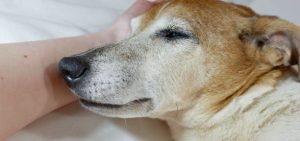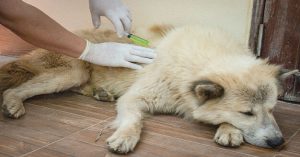Yellow diarrhea in a dog that seems otherwise healthy may indicate a dietary issue or infection. Consult a vet to rule out serious conditions.
If your dog is experiencing yellow diarrhea yet appears to be in good spirits, it’s important not to overlook this symptom. Yellow stool can be a sign of a variety of health issues ranging from dietary indiscretion to more complex conditions like liver dysfunction or even parasites.
It’s essential to monitor your pet closely, as diarrhea can lead to dehydration and other complications if it persists. Observing changes in your dog’s behavior, appetite, and overall health can provide critical information for your veterinarian. Early intervention is key to ensuring that whatever the underlying cause, your dog can be treated promptly, preventing more serious health problems. Make sure to maintain a record of your dog’s symptoms and diet, as this information will greatly aid your vet in diagnosing and treating your furry friend.
Understanding Yellow Diarrhea In Dogs
If your four-legged friend seems perfectly perky yet presents with yellow diarrhea, you might understandably be puzzled and concerned. Normally, a healthy dog’s stool should be chocolate brown. Changes in stool color can tell a lot about your dog’s health. While it’s relieving that your dog is acting fine, yellow stools can indicate underlying health issues that shouldn’t be ignored. In this comprehensive guide, we’ll dive into what could be causing this colorful concern.
Causes Of Yellow Stools
Dogs may experience yellow diarrhea for various reasons. Common culprits include:
- Intestinal infections: Bacteria, viruses, or parasites can disrupt normal digestion.
- Dietary changes or food intolerances: Sudden switches in diet or sensitivities to certain ingredients can result in yellow stools.
- Stress: Anxiety-inducing situations can lead to gastrointestinal upsets.
- Liver or gallbladder issues: Problems with these organs can interfere with digestion and waste processing.
- Exocrine pancreatic insufficiency (EPI): Insufficient digestive enzymes from the pancreas can cause malabsorptive diarrhea.
The Role Of Bile In Stool Coloration
Bile, a fluid produced by the liver and stored in the gallbladder, is essential for the proper digestion of fats. It also imparts a characteristic color to your dog’s stool. Normally, the digestion process colors the stool brown; however, a disruption in bile secretion or an overly rapid transit of food through the intestines can lead to a lighter or yellow shade. The yellow color in diarrhea might stem from a condition known as bile pigment called bilirubin, which forms when red blood cells break down.
When To Consider It A Warning Sign
Although your dog may seem fine, yellow diarrhea is a flag that needs your attention. Prompt veterinary consultation is necessary if you notice:
- Yellow diarrhea persisting more than a day or two
- Pain or discomfort in your dog, as indicated by whining or reluctance to move
- Any accompanying symptoms such as vomiting, loss of appetite, or lethargy
- Signs of dehydration, such as dry gums or decreased skin elasticity
It’s important to rule out serious conditions like liver or pancreatic issues, which may require immediate medical intervention. A vet visit will likely involve a thorough examination, stool analysis, and possibly blood work to pinpoint the cause and prescribe the appropriate treatment.
My Dog’s Behavior Seems Normal
Assessing Overall Health Despite Diarrhea
To truly gauge your dog’s well-being, it’s essential to look at the big picture. Dogs are resilient creatures, and they may not always show their discomfort. When facing something as concerning as yellow diarrhea, take a step back and assess their overall health. Monitor their eating habits, check for dehydration by gently pinching their skin to see if it snaps back, and assess their energy level. Even if your dog appears happy, these checks can reveal underlying issues that might require a vet’s attention.Importance Of Monitoring For Changes
While your dog’s demeanor may not have shifted, it’s crucial to monitor them closely for any changes in behavior or health. Create a checklist of their normal activities and bodily functions to help track any deviations. Look for signs like:- Variations in appetite or water intake
- Sudden weight loss or gain
- Changes in urination habits
- Altered sleep patterns
- Other unusual behaviors
Diet And Yellow Diarrhea
Impact Of Diet On Stool Color
The food that your canine companion consumes has a direct impact on the color and consistency of their stool. Normal dog feces are generally brown due to the presence of bile, which is secreted into the digestive tract to aid in the digestion of fats. When a dog’s stool appears yellow, this could indicate that the food is moving too quickly through the digestive system, not allowing bile to turn it the typical brown color. Below are factors that show how diet influences stool color:- High-fat meals may speed up intestinal transit, leading to a lighter stool color.
- Presence of artificial colors in dog food can also alter stool hue.
- Simple carbohydrates, like those in wheat, can ferment in the gut and give the stool a yellowish tint.
- Food intolerances or allergies might cause rapid food transit and poor absorption, resulting in yellow diarrhea.
Foods Known To Cause Yellow Stools
Identifying specific ingredients that lead to yellow stools can require a little detective work. Some dogs might react to certain foods differently than others, but here’s a list of common culprits:| Food Type | Reason for causing yellow stools |
|---|---|
| Dairy Products | Lactose intolerance leading to rapid digestion |
| Rich Fatty Foods | Causes faster movement through the gut |
| High-Sugar Foods | Fermentation in the intestines, leading to discoloration |
| Spicy Meals | Can irritate the gut and speed up digestion |
| Color Additives in Dog Treats or Food | Non-natural dyes can change feces color |
Identifying Food-related Issues
Common Dietary Culprits For Canines
Fido’s diet could be packed with problematic ingredients that may not sit well with their stomach. Like humans, dogs can have sensitivities that impact their digestion:- Lactose intolerance – Dairy products, although tempting treats, can lead to digestive woes.
- Gluten sensitivity – Gluten-rich foods might be hard for some dogs to process.
- High-fat contents – A diet with excessive fats can strain your dog’s digestive system.
- Spicy foods and additives – Ingredients that are fine for humans could be harmful to dogs.
How To Pinpoint Offending Ingredients
Pinpointing the exact ingredient causing your canine’s condition can seem daunting, but there’s a strategic way to tackle it:- Start with a food diary – Keep track of everything your dog consumes, noting when symptoms appear.
- Implement an elimination diet – Gradually remove suspected ingredients and monitor any changes.
- Consult with a veterinarian or a canine nutritionist – Their expertise can offer valuable insights into potential food intolerances and allergies.
- Observe your dog’s response – Watch for any alterations in symptoms as you adjust their diet.
Health Conditions Causing Yellow Stools
Liver And Gallbladder Disorders
The liver is an essential organ in your dog’s body, responsible for numerous functions, including digestion and toxin removal. The gallbladder stores bile produced by the liver which aids in digestion. Malfunctions in these systems can result in yellow diarrhea, often indicative of a bile duct obstruction or liver disease. When the liver is not working correctly, or the bile flow is disrupted, the body might expel yellowish stool. Common disorders include:- Hepatitis: Inflammation of the liver.
- Cholangitis: Inflammation of the bile ducts.
- Gallstones: Hardened deposits within the gallbladder.
- Cholecystitis: Inflammation of the gallbladder.
Intestinal Infections And Their Symptoms
Intestinal infections, such as viral or bacterial infections, can cause disruption in your dog’s stomach and intestines, leading to yellow diarrhea. These infections might result from ingesting contaminated food or water, or exposure to other infected dogs. Symptoms accompanying intestinal infections can include:- Vomiting: An early sign of gastrointestinal upset.
- Fever: The body’s response to fight off infection.
- Lethargy: An unusual level of tiredness or lack of energy.
- Loss of appetite: A common symptom when a dog is not feeling well.
Infection Or Irritation Signs
Recognizing Subtler Symptoms
Subtle signs can sometimes be the only hint that your dog is experiencing gastrointestinal distress. Keep an eye out for:- Mild lethargy or a decrease in their usual playfulness
- Slight changes in appetite, such as a reduced interest in food
- Excessive licking of the anus or abdominal area
- Increased thirst, which could indicate the body’s attempt to compensate for lost fluids
When The Condition May Need Veterinary Attention
It’s critical to discern when home care is sufficient and when it’s time to seek professional help. Consider scheduling a visit to the veterinarian if you notice:| Sign | Explanation |
|---|---|
| Persistent diarrhea | Diarrhea that lasts longer than 24 hours can lead to dehydration and other complications. |
| Accompanying vomiting | Vomiting along with diarrhea can intensify the risk of dehydration. |
| Blood or mucus in the stool | These can be signs of bacterial infections, parasitic infestations, or other serious conditions. |
| Fever | A high body temperature may indicate an underlying infection that requires treatment. |
Diagnosis And Testing
Importance Of Veterinary Diagnostic Tests
When it comes to the health of your canine companion, timely and accurate diagnosis is essential. Veterinary diagnostic tests can detect hidden ailments, preventing minor issues from escalating into more serious conditions. They not only provide peace of mind but also tailor treatment plans effectively based on precise diagnostics, which is vital for the rapid recovery of your pet.Stool Analysis And Other Examinations
A comprehensive stool analysis is typically the first step a veterinarian will take. This examination helps in identifying the presence of parasites, unusual bacteria, viruses, or signs of digestive distress. The analysis can unveil a lot about your dog’s internal health and guide further testing if required. Besides the stool test, vets might recommend additional examinations depending on the stool analysis results and the dog’s overall health status. These may include:- Blood tests to assess organ function and detect infections
- Ultrasound to visualize internal organs
- X-rays to rule out obstructions
- A physical examination to check for signs of pain or discomfort
Home Care Vs. Veterinary Consult
Safe At-home Observations And Treatments
Initial at-home care includes monitoring your dog’s behavior and diet:- Hydration: Ensure constant access to fresh water to prevent dehydration.
- Diet: Consider offering a bland diet, such as boiled chicken and rice, which can be gentle on an upset stomach.
- Rest: Provide a comfortable resting area to help them recover.
- Monitor stool frequency and color changes.
- Check for appetite loss or behavioral modifications.
- Look for other symptoms such as vomiting or lethargy.
Signs Your Dog Needs Professional Help
Some scenarios necessitate an immediate veterinary consultation. Pay attention to these signs:| Warning Signs Requiring Veterinary Attention | |
|---|---|
| Symptom | Action |
| Persistent diarrhea | Contact your vet, especially if lasting over 24-48 hours |
| Blood in stool | Immediate veterinary consultation is critical |
| Extreme lethargy | Seek veterinary care to rule out serious conditions |
| Vomiting | Consult with a vet, as this may indicate systemic issues |
| Signs of dehydration | If signs like dry gums or sunken eyes are present, visit the vet promptly |
Treatment Options Available
Dietary Changes And Medication
One of the first lines of defense against yellow diarrhea in dogs involves reviewing and, if necessary, altering their diet. Simple dietary changes can sometimes resolve digestive issues. Here are some steps you might take:- Temporarily switching to a bland diet of boiled chicken and rice
- Introducing easily digestible foods over several days
- Ensuring consistent access to fresh water to prevent dehydration
- Avoiding fatty, spicy, or unusual foods
| Medication Type | Benefits |
|---|---|
| Antibiotics | Treat underlying bacterial infections |
| Probiotics | Assist in restoring healthy gut flora |
| Anti-parasitic drugs | Eradicate parasites that could be causing issues |
| Anti-inflammatory drugs | Reduce intestinal inflammation |
Probiotics And Their Benefits
Probiotics, the beneficial bacteria that live in the digestive system, play a crucial role in maintaining gut health. Introducing probiotics is an excellent way to support your dog’s digestive system, especially when they have diarrhea. Here are some notable benefits:- Restore natural gut balance by replenishing good bacteria
- Improve digestion and nutrient absorption
- Strengthen the immune system
- Alleviate symptoms of gastrointestinal upset
Ensuring Recovery And Health
Monitoring Your Dog Post-treatment
After treatment, careful observation is essential. Look for signs of improvement in both behavior and stool consistency. Here’s how to stay on top of your dog’s health:- Consistency of Stools: Check if the stools return to their normal color and firmness.
- Appetite and Hydration: Ensure your dog is eating well and drinking enough water.
- Activity Levels: Your dog should gradually return to their usual energy levels.
- Follow-Up Visits: Attend all recommended vet appointments for further assessments.
Preventative Measures For Future Well-being
Prevention is always better than cure. To safeguard your dog’s ongoing health, consider these proactive steps:| Preventative Strategy | Description |
|---|---|
| Diet | Maintain a balanced diet and be cautious with new foods. |
| Hydration | Ensure your dog has constant access to clean water. |
| Parasite Control | Administer regular flea and worm treatments as prescribed. |
| Exercise | Keep up with consistent and appropriate exercise routines. |
| Stress Reduction | Minimize environmental stressors and provide a stable home environment. |
Frequently Asked Questions
Why Is My Dog’s Diarrhea Yellow?
Yellow diarrhea in dogs can indicate a rapid transit of food through the gastrointestinal tract or problems with the liver, gallbladder, or pancreas.
Can Dogs Act Normal With Yellow Diarrhea?
Dogs can act normal despite experiencing yellow diarrhea, though it’s important to monitor them for any behavior changes or worsening symptoms.
What Causes Yellow Stool In Canines?
Yellow stool in canines can be caused by dietary indiscretions, food intolerance, infections, or issues with the liver, pancreas, or gallbladder.
Should I Worry About Yellow Dog Diarrhea?
If your dog has yellow diarrhea but is otherwise acting fine, it’s wise to observe them closely and consult a vet if it persists or other symptoms appear.
What Diet Helps With Yellow Diarrhea In Dogs?
A bland diet, typically boiled chicken and rice, without any spices or additives, can help settle a dog’s stomach and firm up their stool.
When To See A Vet For Dog’s Yellow Diarrhea?
It’s time to see a vet if your dog’s yellow diarrhea lasts more than a day or two, is accompanied by vomiting, lethargy, or loss of appetite.
Conclusion
Watching your dog suffer from yellow diarrhea can be unsettling, yet their playful demeanor may offer some solace. Always prioritize a vet consultation to rule out serious conditions. Remember, proper diet, hydration, and healthcare are your pet’s allies against digestive woes.
Stay vigilant for any behavioral changes, and ensure your furry friend maintains a clean bill of health.
Related posts:
 What Home Remedy is Good for a Dog With Bloody Diarrhea? 5 Powerful Solutions
What Home Remedy is Good for a Dog With Bloody Diarrhea? 5 Powerful Solutions
 Best Diarrhea Medicine for Dogs : Top-rated Solutions Revealed
Best Diarrhea Medicine for Dogs : Top-rated Solutions Revealed
 How to Get Dog Hair off Clothes Without Lint Roller: Easy Hacks!
How to Get Dog Hair off Clothes Without Lint Roller: Easy Hacks!
 My Dog Has Diarrhea But Is Acting Fine: Quick Solutions!
My Dog Has Diarrhea But Is Acting Fine: Quick Solutions!
 What to Do for a Dog With Diarrhea | Quick Relief Tips
What to Do for a Dog With Diarrhea | Quick Relief Tips
 What to Give a Dog for Diarrhea? Expert Tips
What to Give a Dog for Diarrhea? Expert Tips

